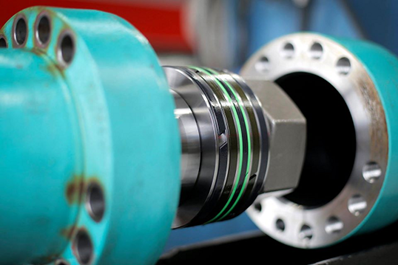Hydraulic Maintenance Checklist for 2024
.jpg?width=397&height=265) Numerous industries rely on hydraulic systems to get work done and handle various tasks, from heavy lifting to compacting and pressing. Hydraulic systems contain multiple parts and components. Just like other types of machinery, the parts and components wear out and need to be replaced.
Numerous industries rely on hydraulic systems to get work done and handle various tasks, from heavy lifting to compacting and pressing. Hydraulic systems contain multiple parts and components. Just like other types of machinery, the parts and components wear out and need to be replaced.
This comprehensive hydraulic maintenance checklist is designed to assist maintenance technicians and hydraulic system operators in efficiently carrying out routine maintenance tasks. By using these checklists, you can ensure hydraulic systems operate smoothly, mitigate potential issues, prolong their lifespan, and achieve optimal performance. With guidelines specific to 2024, this checklist covers all essential aspects of hydraulic maintenance tailored to the most up-to-date standards and practices.
Hydraulic System Maintenance Checklists
Your maintenance procedures should include three different hydraulic system checklists: daily, weekly, and monthly. It is essential to maintain a record of all performed maintenance tasks, including date, description of work done, and parts replaced or repaired. This documentation will help track upkeep and identify patterns over time.
Daily Hydraulic System Maintenance Checklist
- Check the system operator’s log for any service or maintenance requests or problems they noticed during their shift.
- Check for leaks in hydraulic lines, hose connections, and fittings.
- Check the hydraulic reservoir fluid level and add fluid if necessary.
- Inspect hoses and connections for signs of cracking and breaking.
- Check and tighten connections, screws, fittings, etc.
- Start the system and listen for strange noises or pressure issues.
Weekly Hydraulic System Maintenance Checklist
Your weekly maintenance tasks should include all of the daily maintenance tasks, as well as the following:
- Check fluid condition: Inspect the hydraulic fluid reservoir for leaks and replace the fluid according to manufacturer guidelines if necessary.
- Check pressure settings: Verify that the system’s pressure settings are within the specified parameters outlined in your equipment manufacturer manual or instructions.
- Clean filters: Regularly clean or replace hydraulic filters to maintain the efficient operation of the system and prevent contaminants from causing damage.
- Lubricate moving parts: Apply lubrication to bearings, pistons, actuators, and other moving parts as the manufacturer recommends for smooth movement and reduced wear.
- Test safety features: Ensure emergency stop buttons, pressure relief valves, and other safety features function properly. Test these features regularly to guarantee their effectiveness in case of an emergency.
- Check battery voltage: If your hydraulic system is equipped with a battery-powered backup or control system, verify the voltage to ensure it remains within acceptable levels. Charge or replace batteries as needed.
- Inspect hydraulic cylinders: Examine hydraulic cylinders for leaks, damage, or signs of wear. Take note of any abnormalities and address them promptly.
- Clean the system: Keep the entire hydraulic system clean by removing dirt, debris, and contaminants that may hinder its performance or lead to excessive wear.
Monthly Hydraulic System Maintenance Checklist
Your monthly maintenance tasks will include all the daily and weekly tasks, as well as these tasks:
- Inspect a sample of hydraulic oil for signs of potential fluid contaminants, such as metal shavings, water, or aeration.
- Review the system operating hours to determine if the hydraulic oil and filters need to be changed.
- Inspect the couplings on hydraulic pumps, motors, cylinders, and other hydraulic system components.
- Perform a detailed test to check pressure levels, system temperature ranges, listen for starting noises, etc.
- Repair and replace hydraulic parts and components based on the number of service hours or operating conditions as needed.
- Inspect seals for signs of excessive wear and friction and replace them if necessary.
- Inspect the condition of rods and look for signs of wear, pitting, and corrosion, and replace if necessary.
Hydraulic System Maintenance Options

When it comes to hydraulic system maintenance, businesses have four different options:
Option #1: Reactive Maintenance
Reactive maintenance is often considered the most expensive. It is where you wait for your hydraulic system to start having problems or until it breaks down before you do anything to fix and repair the system. The problem with this type of maintenance is that, depending on what breaks, your system could be down for several hours to several days or longer.
As a result, work comes to a complete halt until you can get the system repaired. In the meantime, you are losing money because your workers cannot complete their tasks.
Option #2: Corrective Maintenance
This type of maintenance is performed in response to a detected problem or malfunction in the hydraulic system. It involves repairing or replacing faulty components, troubleshooting and diagnosing issues, and ensuring the system returns to its normal operation as quickly as possible. Corrective maintenance aims at restoring functionality rather than preventing future system failures.
Option #3: Preventative Maintenance
Preventative maintenance is performing regular maintenance and system checks to help identify potential problems before they occur. When a problem is detected, it is fixed and repaired right away.
This approach is less costly than reactive or corrective maintenance since you are not waiting for something to go wrong. Rather, you are preventing potential problems with hydraulic pumps, motors, cylinders, seals, etc.
Option #4: Predictive Maintenance
Predictive maintenance is considered a hybrid version of preventative maintenance. Sensors collect data about the hydraulic system, pumps, motors, and related components. The sensor data is fed through a special software application.
When the software application determines something is operating outside of acceptable parameters, it sends an alert that maintenance is required. Using this type of maintenance ensures that system maintenance is completed at the precise moment it’s needed.
What Type of Maintenance Is Best?
The best type of maintenance strategy for a hydraulic system depends on several factors, including the specific needs and requirements of the system, budget constraints, operational demands, and risk tolerance. However, in general, a combination of preventive and predictive maintenance is considered the most effective approach for optimizing the performance and longevity of hydraulic systems.
Preventive maintenance programs allow you to proactively schedule routine inspections, checks, lubrications, filter replacements, and cleaning tasks. This helps identify potential issues before they cause major problems or breakdowns. Regular upkeep can prevent unexpected failures while ensuring that the system operates efficiently.
Predictive maintenance takes maintenance a step further by leveraging advanced technologies, such as condition monitoring sensors or data analytics software. It enables real-time monitoring of key parameters like temperature variations, vibration levels, pressure fluctuations, or fluid quality in order to predict when certain components may fail. By closely tracking these indicators and implementing corrective measures promptly when necessary, instead of waiting for complete failure or breakdowns, it minimises downtime while increasing reliability.
Reactive and corrective maintenance—repairs after hydraulic component failure—can’t be avoided entirely due to unforeseeable circumstances sometimes arising in complex hydraulic systems. However, reactive-only approaches are generally not recommended as they tend to lead to extended periods of downtime with associated financial costs.
As such, over the past several years and during 2024, preventative maintenance and predictive maintenance have demonstrated lower costs than reactive maintenance, although the costs of the sensors and computer applications needed with predictive maintenance are not something that every business can afford.
This is why most operations will use preventative maintenance and create checklists that detail a wide range of procedures to be performed at set intervals. These same checklists can also be used with predictive maintenance programs.
Hydraulic System Maintenance Tips
It is essential to keep a detailed record of hydraulic system maintenance no matter which type of maintenance you use. Essentially, your system records are your maintenance checklists since your maintenance technicians will use the lists to perform maintenance.
Additionally, these records can help identify potential problems. Not to mention, you can quickly see what maintenance was performed, when it was completed, who performed it, and what hydraulic hoses, parts, and components were replaced.
Other Hydraulic System Maintenance Checklists

Besides daily, weekly, and monthly checklists, you should have quarterly and annual checklists with their own detailed list of tasks to be performed. When creating your checklists, it is important to remember that hydraulic fluid and most hydraulic equipment component replacements are based on the number of service hours.
For example, if a hydraulic pump is rated to operate for up to 10,000 hours, consider replacing it at that interval, instead of continuing to use it. Granted, the pump may last several thousand hours more. So, you should monitor it closely or rely on your sensors if you use predictive maintenance to let you know when to replace it.
By performing regular preventative maintenance and predictive maintenance, you can avoid safety hazards and other potential damages to your hydraulic systems.
Be Prepared for Hydraulic Maintenance with the Parts You Need
Being prepared for hydraulic maintenance requires having the right parts inventories on hand when you need them the most. To find hydraulic motors, pumps, cylinders, parts, and components, please register online to browse our inventories or contact White House Products, Ltd. at +44 (0) 1475 742500 today.
Back to blog posts